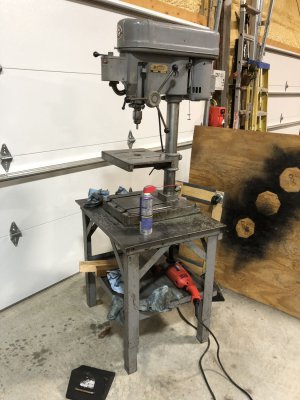The craptastic “Clarke” import drill press I’ve been suffering with for 20 years was the subject of a POTD where I put the spindle in the lathe and remachined the JT3 taper on the removable arbor to get rid of the 0.060 (!) runout. I improved it to 0.006, measured while still in the lathe. Back in the press, it was great for a while. Now, the runout is back up to 0.035, measured on a 0.450 gauge pin in the chuck. Belt tension bows the spindle, which only runs on two bearings and carries the pulley, and the quill is short and narrow.
So, I’ve been looking for a better drill press to replace it. Last week I tried to buy a Walker-Turner WT-900 press from about 1950 that was on FB Marketplace, but, as usual, couldn’t get there quickly enough and someone else grabbed it.
I had looked at a new Jet, available locally for about $1600, and a Powermatic that was even more than that. Uh, no. Even if they are great, that’s too much to spend on a mere drill press when I don’t yet have a mill.
But I did finally decide I was going to have to pay eBay prices for a vintage American-made press, just so I could actually buy it.
I looked at Walker-Turner, Buffalo, and Delta. I saw a Buffalo Model 18 that was appealing, but I’d have to drive 150 miles to get it and the price was still in the upper three figures. And who knows what it would need, being 70 years old and a bit derelict.
I didn’t want a 17-20” press with power feed and all that. I want something I can move around and I just don’t need to drill 1” holes in steel. And I didn’t want to spend mill money.
Finally, I bit on a 15” Delta, a 15-665 from 1970, which is the 6+6 model with six speeds and 6” of quill travel. It’s a bench model mounted on a sturdy steel table that had come out of a fab shop in Baltimore. I thought it might be too light, until I compared it to what I have, and before I’d read up on the model from documentation on Keith Rucker’s site and testimonials here and on other forums.
My Tractor Supply special has a 3/4-HP motor, a 5/8” chuck, and speeds down to 280 RPM. The Delta has a 1/2-HP motor, a 1/2” chuck, and a single-belt drive with a lowest speed of 450 RPM. But look again: the import “3/4-HP” motor draws 7.4 amps, and the Dayton motor on the Delta draws 8 amps. Typical HP fiction.
The lowest speed of 450 is the only complaint. In every other dimension, the Delta blows the doors off the import. I was able to inspect it under power today before buying it, and I took along a dial indicator. TIR is 0.0035 on the side of that 0.450 gauge pin. That’s even a bit better than Jacobs’s claim for the 34-33C chuck, which is rated at 0.004.
The Delta is much heavier, and it made me realize that my old one didn’t really earn that 5/8” chuck capacity.
And the old Delta is smooth. The pulleys are balanced and even at the top speed of over 5000 RPM there is no vibration. The old one dances around at its top speed of 3100 RPM, in part because it’s too light.
The table needed stoning badly, but tramming it after that required only two taps of a deadblow and retightening the tilt bolt to get the table within 0.002 of perpendicular in both axes using my dual-indicator tramming fixture.
It has a table, unlike most bench models, which makes up for not having anything to assist raising the head. I might add that at some point to take advantage of the t-slots in the base casting.
And I might install an 1140 RPM motor for the rare occasions when I need to use those S&D drills in steel.
And I wondered what I was giving up not have a Morse-taper spindle. But the chuck is clamped to the JT33 taper using a screwed collar, which I have decided is a better arrangement. I’ve certainly never used anything but a chuck in the old press.
The Delta push-button on-off switch has been replaced by a forward-reverse drum switch. That was a big selling point for me—this press should be able to do power tapping within reason.

I had to use a hoist to get it off my trailer—the press and its table easily weighs 300 pounds. The table top is 3/16 plate on angle legs.
Now to find casters for it that flip down onto solid feet.
Rick “test drilling tomorrow” Denney

